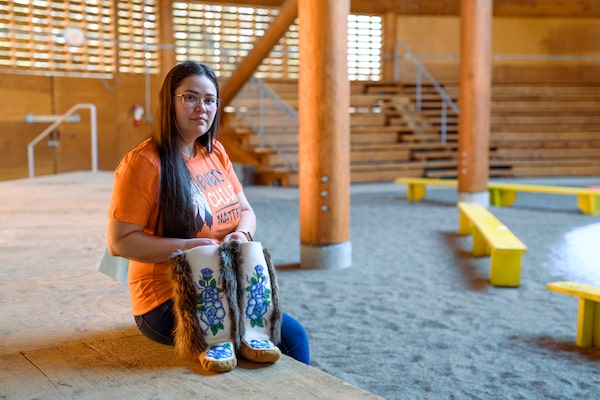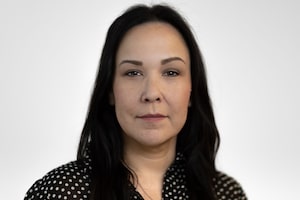
Taylor Behn-Tsakoza from Fort Nelson First Nation, B.C., is one of two youth representatives who are part of the Assembly of First Nations’ official delegation to the Vatican.Tracy Rondeau/The Globe and Mail
Métis fiddler Alex Kusturok says performing the catchy, plucky tune of the Red River Jig for Pope Francis next week at the Vatican is the natural choice for showcasing his vibrant, unique culture to the Holy Father and other Catholics in attendance.
If played right, the audience favourite among Métis and First Nations people in Canada has the power to hit “you in the chest and in the heart,” said Mr. Kusturok, comparing the jig to the spiritual energy of the First Nations round dance at pow wows.
“I think to have that in the Vatican is going to be so special,” said the 30-year-old fiddler from Cold Lake, Alta. “And to hear the fiddle ring and the acoustics that they have there, it’s going to be powerful.”
It’s unlikely the Vatican walls have ever reverberated with musical sounds rooted in Indigenous cultures and traditions from Canada, but it’s through those melodies, paired with stories of the horrific abuses committed by the Catholic Church in its role in Canada’s shameful residential school legacy, that younger Indigenous delegates such as Mr. Kusturok will deliver messages of truth and reconciliation in a historic visit.
Indigenous leaders call on Catholic Church to hasten reparations
Metis fiddler Alex Kustorok will perform for Pope Francis next week at the Vatican as part of the delegation of 32 residential school survivors, elders, youth and knowledge keepers.Megan Albu/The Globe and Mail
The performers are going to Rome to support the Métis delegation. The Métis National Council, Assembly of First Nations and Inuit Tapiriit Kanatami are sending a total of 32 delegates of residential school survivors, elders, youth and knowledge keepers, according to the Canadian Conference of Catholic Bishops, which is co-ordinating and paying for the trip. The groups will meet privately with the Pope, and it’s expected that a larger group of Indigenous peoples will join them for a final audience with the pontiff on April 1.
While Mr. Kusturok no longer considers himself a youth, he is part of the younger generations of residential school survivors speaking out about the effects on their families and cultures.
His paternal grandmother is a residential school survivor who moved often to keep her own children, including Mr. Kusturok’s father, from attending the federal and church-run institutions in Northern Ontario because of her own experiences there.
“He didn’t go to [public] school for the first time until he was nine or 10 years old,” Mr. Kusturok said of his First Nations father.
Now a new father himself, Mr. Kusturok doesn’t consider himself an intergenerational survivor, although he acknowledges that residential schools may have been a contributing factor to the alcoholism both he and his father experienced. His father has been sober for more than 30 years; Mr. Kusturok has been in recovery for three years.
Mr. Kusturok received his First Communion but doesn’t consider himself a practising Catholic now. He says that while the Catholic Church has earned the hostility it receives from some survivors and communities for its role in residential schools, it’s not the faith that’s at fault.
“It’s not the teachings, it’s the flawed people,” he said.
He is encouraged by the Pope’s willingness to meet privately with survivors and elders in three one-hour meetings and said he will be there to support them.
“They’re the ones that are going there to be open and honest and vulnerable,” he said.
Mr. Kusturok has been connected to his Métis culture since before he could walk. He remembers his grandmother carrying him around the dance floors while his Métis mother performed with her fiddle throughout Manitoba on weekends to help pay the bills.
His father played guitar, but Mr. Kusturok was drawn to the tunes coming from his mother’s old Métis fiddle CDs when she wasn’t performing herself.
“The tunes make you feel a certain way,” he said.

Taylor Behn-Tsakoza is bringing a brand new pair of mukluks, made for her by her mother and her aunt, who is a residential school survivor.Tracy Rondeau/The Globe and Mail
For Taylor Behn-Tsakoza of the Fort Nelson First Nation, in Northern B.C., going to the Vatican has sparked a mix of emotions – it’s both an honour to represent her generation and a time to reflect on the harmful legacy of the schools.
The 26-year-old is one of two youth representatives in the Assembly of First Nations’ delegation.
Ms. Behn-Tsakoza is an intergenerational survivor – her aunties and uncles were forced to attend residential schools, and her dad went to a day school in Northern B.C.
“I was born in 1996, the year the last residential school closed. Although I never attended, I absolutely still suffer the effects and impacts of residential school,” she said. “Going to the Vatican, as the youth representative, is really something that I don’t take lightly.”
“My generation that’s coming up – we’re more educated, we’re the fastest-growing demographic in Canada right now,” she said. “But it’s like, still, when you go anywhere, any big city, the people who are on the streets are our relatives or people that look like us. It’s hard to feel proud and feel like we’re moving in another direction, but then you get hit with the reality that our people are still really hurting and they’re angry and they’re lost.”
More than 150,000 First Nations, Métis and Inuit children were taken from their families to attend the church-run, government-funded schools, where they were punished for speaking their own languages and practising their cultures. Thousands of students were abused, and many never returned home.


Judy Sackaney and her grandson visit a memorial on Parliament Hill honouring the 215 children whose remains were found at the grounds of the former Kamloops Indian Residential School at Tk’emlups te Secwépemc First Nation in Kamloops, B.C., in June 2021. Rows upon rows of children's shoes represent the lives lost.Justin Tang/The Canadian Press
The effects linger today. “I can’t speak my language,” Ms. Behn-Tsakoza said. “I wish I could, but it was a trauma from residential school – my grandparents didn’t pass it on to my parents or my aunties or uncles.”
Her parents are both Dene – she is of Eh Cho Dene and Dunne Zaa ancestry.
She’s been meeting over Zoom with other delegates for months, planning the trip. In that time, “I’m listening and I’m hearing and I’m taking in all the stories and all the perspectives that the rest of our delegation has to share. But I also realized: I have a story to share as well. Being an intergenerational survivor, that’s part of this history.”
She is bringing a brand-new pair of mukluks, made for her by one of her aunties, a residential school survivor, and her mother. She’ll also be bringing medicines from her territory, carrying stories and teachings and prayers from her friends and family back home.
She will get to convey her message to the Pope directly, in a one-hour private meeting between the First Nations delegates and the pontiff on Thursday. As the last speaker, she will have about five minutes to address him. She said she wants to bring a sense of hope about the relationship between the church and Indigenous people and the path of reconciliation.
She wants to hear the Pope say, “I am sorry” – and do so in the form of an apology made in Canada. But what comes after matters more, she said, in terms of concrete actions. “That’s what’s going to really mean something.”
Our Morning Update and Evening Update newsletters are written by Globe editors, giving you a concise summary of the day’s most important headlines. Sign up today.
 Willow Fiddler
Willow Fiddler Tavia Grant
Tavia Grant